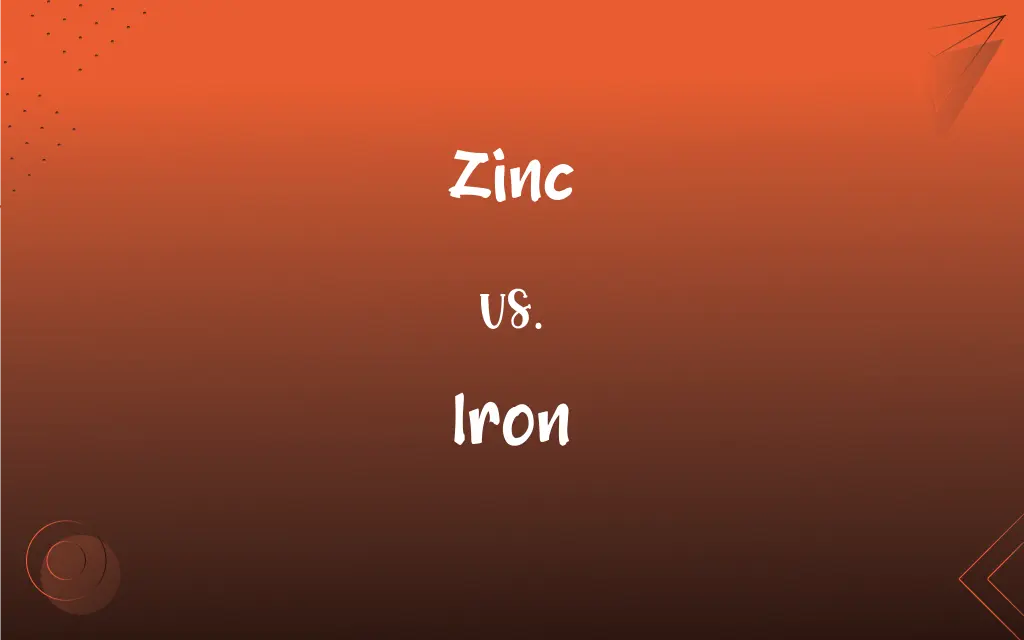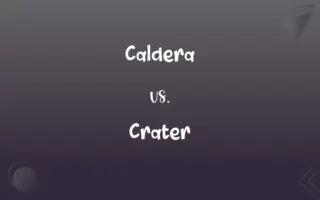Zinc vs. Iron: What's the Difference?
Edited by Aimie Carlson || By Harlon Moss || Published on January 26, 2024
Zinc is a bluish-white, corrosion-resistant metal used in alloys and galvanizing, while iron is a hard, strong metal crucial for steel production and biological functions.

Key Differences
Zinc is a chemical element with the symbol Zn and atomic number 30, known for its bluish-white color and resistance to corrosion. Iron, symbolized as Fe and with atomic number 26, is a common element in the Earth's crust and is known for its strength and magnetic properties.
In industrial applications, zinc is primarily used for galvanizing to protect steel and iron from rusting. Iron, on the other hand, is a key component in steel production, making it fundamental in construction and manufacturing industries.
Biologically, zinc plays a crucial role in various enzymatic functions and immune system health. Iron is essential for hemoglobin in red blood cells, facilitating oxygen transport in the body.
Zinc is less dense and has a lower melting point compared to iron, which makes it easier to work with in certain manufacturing processes. Iron, being denser and with a higher melting point, is used where strength and durability are required.
In terms of abundance, zinc is the 24th most abundant element in the Earth's crust, while iron is the fourth most abundant and the most common element by mass in the Earth.
ADVERTISEMENT
Comparison Chart
Symbol and Atomic Number
Zn, 30
Fe, 26
Physical Properties
Bluish-white, corrosion-resistant
Hard, strong, magnetic
Industrial Use
Used in galvanizing and alloys
Crucial for steel production
Biological Role
Important for enzymes and immune system
Essential for blood oxygen transport
Abundance and Density
Less abundant, less dense
More abundant, denser
ADVERTISEMENT
Zinc and Iron Definitions
Zinc
Essential mineral for human health, supporting the immune system.
Zinc supplements are taken to boost immune function.
Iron
Chemical element with symbol Fe and atomic number 26.
Iron is extracted from iron ore in blast furnaces.
Zinc
A chemical element with symbol Zn and atomic number 30.
Zinc is often combined with copper to make brass.
Iron
A strong, hard magnetic metal used extensively in construction and manufacturing.
The bridge is reinforced with iron beams for extra strength.
Zinc
Used in making batteries, die-casting alloys, and rubber.
Zinc is a key component in many car batteries.
Iron
Vital for biological functions, especially in red blood cells.
An iron-rich diet is important for preventing anemia.
Zinc
A bluish-white metal used in galvanizing and alloys.
The gate was coated with zinc to prevent rust.
Iron
Predominant material used in steel-making.
The skyscraper's framework is made of steel, which contains iron.
Zinc
Known for its anti-corrosion properties in various applications.
Zinc coatings are applied to steel structures to enhance longevity.
Iron
Abundant element in the Earth's crust and the core.
Iron ore mining is a major industry due to its abundance.
Zinc
A bluish-white, lustrous metallic element that is brittle at room temperature but malleable with heating. It is used to form a wide variety of alloys including brass, bronze, various solders, and nickel silver, in galvanizing iron and other metals, for electric fuses, anodes, meter cases and batteries, and in roofing, gutters, and various household objects. US pennies minted after 1982 consist of a copper-clad zinc core. Atomic number 30; atomic weight 65.38; melting point 419.53°C; boiling point 907°C; specific gravity 7.134 (at 25°C); valence 2. See Periodic Table.
Iron
Symbol Fe A silvery-white, lustrous, malleable, ductile, magnetic or magnetizable, metallic element occurring abundantly in combined forms, notably in hematite, limonite, magnetite, and taconite, and used alloyed in a wide range of important structural materials. Atomic number 26; atomic weight 55.845; melting point 1,538°C; boiling point 2,861°C; specific gravity 7.874 (at 20°C); valence 2, 3, 4, 6. See Periodic Table.
Iron
An implement made of iron alloy or similar metal, especially a bar heated for use in branding, curling hair, or cauterizing.
FAQs
Is zinc used in industry?
Yes, zinc is used for galvanizing iron, making alloys, and in batteries.
Can zinc be toxic?
Yes, excessive zinc intake can lead to toxicity symptoms like nausea and immune dysfunction.
What is zinc?
Zinc is a chemical element with the symbol Zn and atomic number 30.
How is zinc obtained?
Zinc is primarily obtained through mining zinc ores like sphalerite.
What are zinc's physical properties?
Zinc is a bluish-silver, ductile metal at room temperature.
Where is zinc found?
Zinc is found in minerals, soil, and is essential in many biological processes.
Are there zinc supplements?
Yes, zinc supplements are available for treating zinc deficiency.
What are the main uses of iron?
Iron is used in steel-making, construction, and manufacturing of various goods.
Where is iron most commonly found?
Iron is found in the Earth's crust and is a key component of hemoglobin in blood.
Is zinc important for health?
Absolutely, zinc is vital for immune function, wound healing, and DNA synthesis.
What foods are high in zinc?
Foods like oysters, red meat, and poultry are high in zinc.
How does zinc react with other elements?
Zinc can react with acids, alkalis, and other metals to form various compounds.
What is iron?
Iron is a chemical element with the symbol Fe and atomic number 26.
What are iron's physical properties?
Iron is a hard, silvery metal that is magnetic and corrosion-prone.
What foods are rich in iron?
Red meat, beans, and fortified cereals are good sources of iron.
How is iron extracted?
Iron is extracted from iron ores like hematite and magnetite through smelting.
Can iron be recycled?
Yes, iron is highly recyclable and often reused in various forms.
How does iron interact with other elements?
Iron reacts with oxygen to form rust and combines with carbon to make steel.
Is iron essential for the human body?
Yes, iron is crucial for oxygen transport in the blood and cellular functioning.
What are signs of iron deficiency?
Symptoms include fatigue, weakness, and pale skin.
About Author
Written by
Harlon MossHarlon is a seasoned quality moderator and accomplished content writer for Difference Wiki. An alumnus of the prestigious University of California, he earned his degree in Computer Science. Leveraging his academic background, Harlon brings a meticulous and informed perspective to his work, ensuring content accuracy and excellence.
Edited by
Aimie CarlsonAimie Carlson, holding a master's degree in English literature, is a fervent English language enthusiast. She lends her writing talents to Difference Wiki, a prominent website that specializes in comparisons, offering readers insightful analyses that both captivate and inform.































































